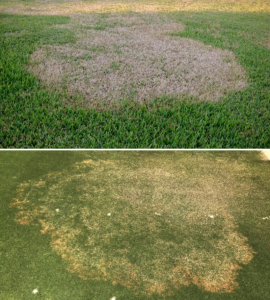Brown patch, large patch diseases plague Texas lawns in cool, wet September
Writer: Gabe Saldana, 956-408-5040, [email protected]
Contact: Dr. Becky Grubbs, 979-845-0603, [email protected]
Contact: Molly Keck, 210-631-0400, [email protected]

COLLEGE STATION — Cases of the turfgrass disease commonly identified as brown patch — more likely large patch in most warm-season turfgrasses — have spiked during a cool September that broke rainfall records across parts of the state, according to specialists with the Texas A&M AgriLife Extension Service.
Large patch and brown patch are caused by different groups of Rhizoctonia solani, a fungal pathogen, said Dr. Becky Grubbs, AgriLife Extension turfgrass specialist in College Station. The group associated with brown patch in cool-season grasses follows a different life cycle from the one responsible for large patch in Texas’ most common warm-season grasses, including St. Augustine and zoysiagrass.
Diagnosis by a certified nursery professional or turfgrass specialist is the best option for accuracy, Grubbs said.
Symptoms
Large patch appears in circular patches across the lawn with outer edges that are typically orange or yellow. Lesions also appear on infected grass sheaths and stems.
“Our weather over the last month provided the disease with perfect conditions to proliferate this fall,” Grubbs said.
People who encounter emerging symptom patches in the lawn might instinctively seek a culprit among insect pests, said AgriLife Extension entomologist Molly Keck in San Antonio.
“But an insect causing these symptoms is unlikely this time of year,” she said. “We know grub worms aren’t feeding as actively, and it’s too wet and cool to support chinch bug populations large enough for sufficient damage.”
And fall armyworms, whose populations also increased in September, cause damage by eating turfgrass leaves, while large and brown patch keep leaves intact as they rot.
Treatment
Grubbs said large patch and brown patch that materialize with cooler, wetter weather should clear up alongside those conditions, but a number of interventions can help revive affected areas that show no improvement with the weather:
— Shut off irrigation.
— Avoid mowing wet turfgrass.
— Remove objects causing excess shade.
— Aerate to improve drainage and air circulation.
— Order a soil test for deep insight on existing problems.
— Apply a fungicide as recommended by a specialist.
— Fertilize while turf is growing as directed by a soil test; reduce fertilizer in shaded areas.
— Discontinue nitrogen application at least six weeks before your area’s historic first frost.
Information on submitting a soil test is available at http://soiltesting.tamu.edu/. A web post by Keck discussing large and brown patch issues for Bexar County is available at http://bexarento.blogspot.com/. The AgriLife Extension web publication How to Diagnose and Manage Large Patch Disease in Warm-season Turfgrass is available at https://tinyurl.com/aggielargepatch.


